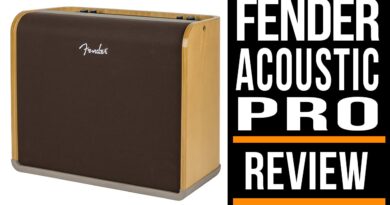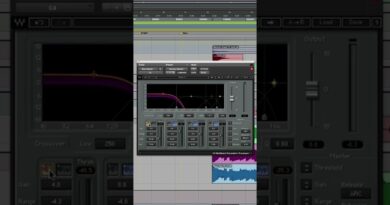Bedroom VS Stage Bass Tone | “I Can’t Hear Myself” | Thomann
The most disappointing moment is when you realise that your awesome bass literally can’t be heard properly. Sometimes our favourite bass sound is not the right one for playing together with others. Enjoy the video and leave a comment below!
Gear used: http://tho.mn/qidey
Recorded in Presonus Studio One: https://bit.ly/S1Pro6
Recorded and mixed with Universal Audio: http://tho.mn/uadx1
Monitors optimised through Sonarworks: http://tho.mn/sonar
We use Cordial cables exclusively: https://www.thomann.de/intl/cat_brand_BF_cordial.html
Interesting bits and pieces:
0:00 Intro
0:27 “Bad” Bass Playing
2:50 “Good” Bass Playing
3:50 Julias Tips
Webshop: https://www.thomann.de
Facebook: https://www.facebook.com/thomanninternational
Twitter: @thomann https://twitter.com/thomann
Instagram: @thomann.music https://instagram.com/thomann.music
Pinterest: https://www.pinterest.com/thomannde/
Visit our blogs:
GER: https://www.thomann.de/blog/de/
ENG: https://www.thomann.de/blog/en/
FRA: https://www.thomann.de/blog/fr/
ESP: https://www.thomann.de/blog/es/
ITA: https://www.thomann.de/blog/it/
NED: https://www.thomann.de/blog/nl/
FIN: https://www.thomann.de/blog/fi/
#Bedroom #Stage #Bass #Tone #Hear #Thomann
Originally posted by UCtvgPVBJ_r1vjN4mRuHCbog at https://www.youtube.com/watch?v=VEi1qraoMgE




Thanks for posting this topic. It's a surprisingly common issue with Bassists.
I been playing bass since 1975. Learned a ton of things about Bass along the way but the one thing that seldom gets discussed is You Tone For The Audience.
I also did Sound for years and started to notice the Bassist himself, is the hardest to please.
They seem to be set in their ways and expect the sound guy to just give them what they got.
I would work with them and most of them finaly get it when playing in a room that they are Not Standing In. They are right in front of their rig.
In short, the guys that finaly get it, are the ones that cleaned up their tones and had a happier show because of it.
I have to admit, I beeing a Bassist learned this doing the sound myself.
Thanks for posting this. I sure makes a difference when you pay attention to everything around you. ????
I use a Rumble amp, Mustang bass and roundwound strings. For my own sound I find that keeping close to flat on all 4 eq controls works for me, maybe backing off on the bottom end at higher volumes, depending on the room. Also sometimes back off the tone control on the Mustang by about 25-30%, again depending on the room.
Also, where you play can make a big difference – up closer to the bridge will tighten up the sound, whereas further away from the bridge makes the sound deeper but slightly less focused. I play with my fingers, but I think the same would apply playing with a pick. I can't comment about slapping and/or tapping since I don't do it.
I was taught many years ago something which may sound counter-intuitive, which is if you want more top end, don't increase the treble, instead reduce the bottom end. Likewise if you want a bit more bottom end you can try cutting the treble a little.
It actually sounded better when it was supposed to be "bad", lol! . That shows that it is just a matter of taste.
So a big piece of advice: If you can, when playing a gig, KEEP YOUR STAGE VOLUME AS LOW AS POSSIBLE. Send a dry direct signal to the house, pre-EQ, and always talk with the front of house engineer, as well as the monitor engineer so that you can get a sound out of your monitors that will satisfy and inspire your best performance, as well as building your confidence in the FOH to give you the sound in the mix that you feel is representative of your contribution to the music. Your amp rig should be as quiet as possible, and be close mic'd. If you have in-ears, trying looking into a Bass Board from Eich amplification. VERY useful. Why? Because the LAST thing you want to do is interfere with the sound coming out of the mains, but being able to feel your low end permeate your body through your feet is more inspirational. Gotta try it yourself to believe it.
EQ is responsible for millions of bass players screwing up their tone. Set it flat and most problems go away.
Another GREAT problem is the fact that some bands has members wich have NO IDEA about dinamics! If you play with the pros you will probably have much more facility for listen your bass too
Reading through the comments I now understand why Flea's isolated lines sound like played on a clothes line with some added highs
One thing I tell bassists on a stage, is just step away from the amp/cabinet. Move closer to center stage and you will get a better sense of how you sit in the mix. The cabinet is designed to project, you're not hearing it right when you are standing right in front of it.
What you got going is an equalization (?) problem. (actually, I think most bands would kill to sound as good as you guys did on the first run there) Try running pink noise through all the amplifiers inputs to find the zero mark. Put the microphone that's doing the calibration out where the listener is, hooked up to a real-time analyzer. And then set all your amplifiers-instruments accordingly. You don't want to get an undefined wall of sound and you want to keep a sound stage three dimensional with sources being right, left, front, and rear. And, we gotta do more unnecessary zooms, with the camera to Julie's face, because she is such a sweet babe and she's got it going on! I could so much fall in love with her! Number one fan boy here.
I usually just set the volume to 8 and control from my bass volume controls. Plus 8 x 10" cabs can correct anything. FORGET FOH !!!
I like to break it into 4 mids, but Bass is always too warbly/boomy to me and Treble is just noise IMO.
120-130 Hz: sounds like a stale low end, but helps you and the drummer to not step on each other
400-600Hz: ugly in the bedroom, but blasts through in a live mix
750-900 Hz – raw and metal-ish. puts an edge to your tone
1200-1500 Hz: adds "air" and provides balance
Would it be silly to say that the amp EQ is for the room and the bass knobs for the playing ?
Thanks Julia. I tried your tips out in a jam session with about 10 other instruments. (I'm the only bass.) I was able to dial in a decent sound that wasn't too boomy or too thin.
Elvey.
Boost 1k with a narrow band
Es ist viel mehr eine Sache der Toneinstellung/Mischen ALLER Instrumenten in der Band. Das heißt, kein anderes Instrument (Gitarre, Klavier, Drums, etc.) darf in den Bassfrequenzen (~30-200Hz, besser noch höher) spielen, ansonsten kann man keine Bassgitarre mehr raus hören, egal wie laut diese spielt. Hier höre ich über das Close mic Sennheiser e902, dass 1. Die Gitarre auf zu viele "Bässe und Low Mids" eingestellt ist. 2. Die Bassdrum darf kein Ton erzeugen (ist ja auch keine Pauke), sondern nur Druck. Hier höre ich ein A heraus in der Bassdrum, da kommt Freude auf, wenn die Band/der Bass in E7 spielt, die ganze "Mischung" bricht zusammen, es wird mulmig. Das hilft wiederum nicht einer Bassgitarre. Fazit: Überall, bei allen Instrumenten die Bässe runter, der einzige, der mit Bässen "spielen" muss und soll, ist der Bassist. Nur meine Meinung.
You're doing one critical thing correctly which you don't mention. Get the speaker off the ground. Scout around the bar for a suitable chair when you are setting up. The higher the better.
Too much bass frequencies will kill any mix, especially in a live setting. It's fascinating how many pro sound engineers fail to understand this, even at the top levels.
The drums dominate everything. Nothing else was focussed.
Not for me I have two Fender Valve State Heads 100 Watts RMS one left and the other right side of drums set, over 4×10 cabinets, some heads roll!!!
Such a glorious-looking bass! Amazing feel & finish (judging with the eyes).
Julia is playing American Deluxe P-bass copy (humbucker at bridge, although split pickup is reversed). Who makes this, and does anyone else make American Deluxe P-bass copies.
I'll never understand why bass players stand right in front of their amps/cabs. Your legs don't have ears, you know. It's a big reason why you can't hear yourself. Meantime, you're blowing my (singer) ears out.
Between this bass example and the guitar example, the real lesson is virtually ANY instrument sounds better individually with a "smile" EQ but every instrument gets LOST in a mix if mid frequencies aren't boosted. The mids are really what human hearing anchors on to distinguish between instruments. This also is a great illustration of the alchemy of recording and mixing music. You can have eight tracks that all sound PERFECT in isolation but didn't get recorded with enough EQ to allow them to MIX together and still provide distinction and separation. There can be other times when something sounds bad in isolation but unexpectedly fits PERFECTLY in a mix. It can take years of playing and recording experience to know how to override those first instincts to record a track for better mixing in the first place.
two easy things when mixing a bassguitar in the foh mix; put a highpass filter on the bassguitar (>90/110hz). If that doesnt work; put a sidechain on the bass channel; steered from the kickdrum channel.
You kind of look like a young Karen Carpenter.
This was really helpful, great video!
Right, noon is a great starting point but sometimes the thing that needs changing is not the EQ or the set up, is a band element, like the guitar player who always plays too loud
What bass is Julia playing?
I have the same bass, and do exactly that with the pick-ups. I usually end up almost fully on the MM pickup, and just tweak it slightly towards the P pickup to add some thump. Amp EQ always all at noon, very rarely need to adjust. I also use some light compression, and bring in OD or fuzz if the song needs it.
sweepable mid freq on the amp is the key for me. bass and treble flat, and a bump in the mids around 250hz helps the bass guitar to be heard
We really need the same kind of video but for metal. It's so insanely hard to get a good live sound with this kind of music, so any help would be welcome.
To my ears, her bass tone and volume mix sounded really good throughout.
Our basses are nearly identical! I just put a Musicman pickup in my P-bass.
I loved the first sound! But then I was listening in my bedroom so ..
You ought to sort out the positions first, get the sounds all coming from one direction, I'm hardly surprised it all sounds messy